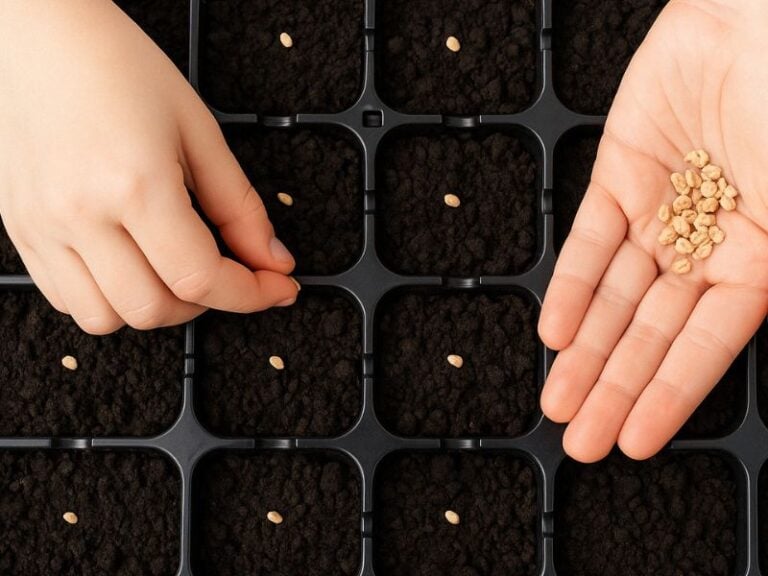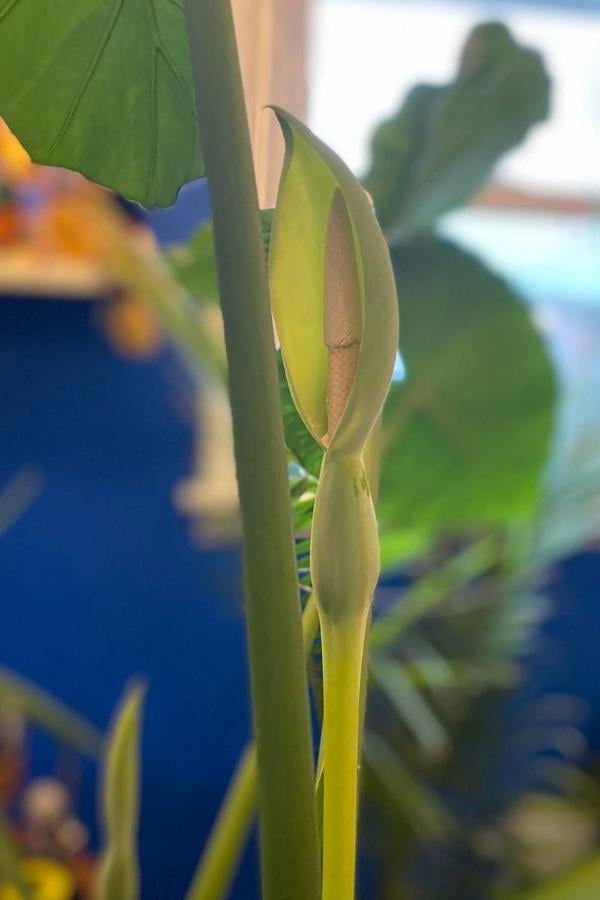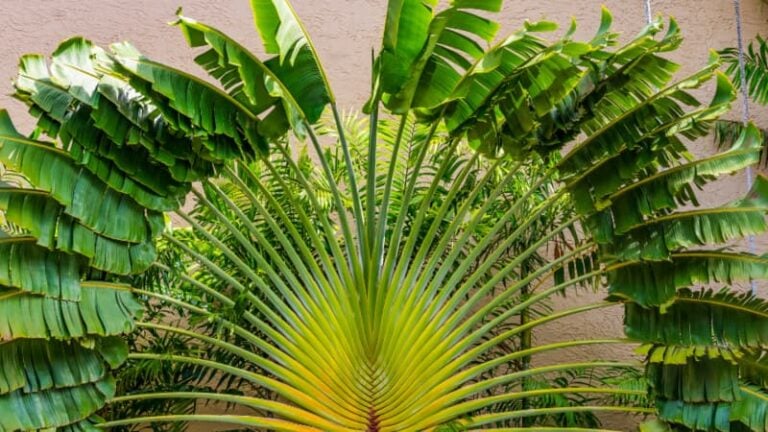Are you concerned about your Elephant Ear plant during the winter? It’s understandable; they don’t like the cold! However, you can protect these dramatic beauties from even the coldest weather by giving them the proper care over the winter.
When the temperature outside reaches 60°F (15°C), bring potted Elephant Ear plants inside. Allow Elephant ear plants to shed their leaves and dig up any remaining bulbs before soil temperatures reach 40°F (5°C). Then, they can be replanted in the spring if properly stored.
Let’s look at how you can give your Elephant Ear a fighting chance against winter terrors.

Contents
What is Overwintering?
When we talk about “overwintering” our plants, we mean the tips and tricks we use to keep them healthy during the winter.
Tropical plants, like the Elephant Ear plant, don’t do well in cold weather and need a little extra care.
Overwintering a plant can be as easy as bringing a potted plant inside or as hard as moving it to a new pot. It all depends on how cold your winter is.
The colder it is, the more work it will take to keep a tropical plant alive through the winter.
Why Overwinter Elephant Ear?
Elephant Ears are a spectacular tropical plant in many cultivars from the Colocasia, Alocasias, and Xanthosomas. While the specific needs of different cultivars can vary widely, one thing they all hate is the cold.
They go into a state of dormancy as soon as winter arrives. The older leaves at the bottom of the tree will be the first to wither.
The plant will die off, leaving behind only the corm, a unique tuberous growth that will spend the winter dormant beneath the surface.
They’ll send up new development when spring comes again and re-grow their showy leaves.
The corm is so fragile that it can’t stand frozen, so even a slight frost will hurt or kill it. Unfortunately, there are many places in the United States where winters get too cold to leave them outside.
The plant will live another year if you bring the corm or the whole plant inside for the winter.
Benefits of Overwintering
Keeping the Plant Alive
Those lavish leaves are sensitive to the cold, so the plant loses them entirely as the seasons change. The corm below the soil could also freeze, especially if you are growing in the north.
You can keep your Elephant Ear’s leaves all winter long by bringing them inside. This will give your home a spectacular pop of tropical delight throughout the cold months.
The overwintering of a potted Elephant Ear plant extends the growing season and promotes year-round growth.
The plant will continue to produce new roots and strengthen its existing leaves and stems, albeit at a slower rate when the weather is cool. However, if you keep it warm and well-lit, it will continue to grow.
Head Start On The Growing Season
If you want to grow Elephant Ears in beds, storing your bulbs over the winter gives you a head start on the growing season.
If your garden bed is still too cold and dark for new growth in the spring, you can encourage it indoors.
Disease Prevention
As spring approaches, gardens frequently become boggy and damp. Even though Elephant Ear plants thrive in beds with consistently moist soil, fungal infections and other diseases can strike the dormant bulbs. They may also rot away completely!
Protection from Pests
Elephant Ear bulbs provide a rich source of nutrition for winter-hungry pests. The bulbs of wide varieties are a nutritious food source for many animals, from soil insects to mammalian and avian predators.
If you dig up bulbs and bring them inside, you can significantly reduce pests’ likelihood of eating them.
Drawbacks of Overwintering
While bringing a pot indoors is relatively simple, digging up and cleaning bulbs is another.
Unfortunately, many in warmer parts of the country prefer to skip the hard work and take their chances with pests, disease, and inclement weather.
Pest and Disease Transmission
There’s always a chance you’ll bring some unwanted visitors inside with you if you bring a potted outdoor plant.
Of course, there will always be a few leaf-eating bugs in a lush, well-balanced outdoor garden, but once they get inside, they can quickly take over even the best-cared-for indoor plant collection.
The same is true for disease. Many plant diseases are caused by fungi and bacteria naturally found in garden soil, so keeping your houseplants away from the outdoors is essential.
Space Requirement
The leaves on Elephant Ear plants are widespread and widespread. Therefore, a potted Elephant Ear requires space to spread its magnificent leaves.
Even small cultivars need a good-sized space in a warm, well-lit area of your home or office to survive the winter.
You may not have enough room to bring in the entire plant if you are growing a large variety, such as the California Elephant Ear (Alocasia gagaena California).
When to Overwinter
How long it takes to winterize an Elephant Ear plant depends on where you live and what kind of Elephant Ear you’re growing.
Understanding USDA Hardiness Zone
Knowing your area’s climate and weather patterns can help you decide if and when to overwinter. The USDA Hardiness Zone map is a great tool created by the United States Department of Agriculture.
This tool makes it simple to grasp the year-round climate conditions in your area by accounting for annual temperature extremes.
The time you need to start overwintering your plants and the effort you will need to put in if they are in garden beds can be determined with a bit of research into your specific climate zone.
Most species of Elephant Ear are winter hardy in the US Department of Agriculture Plant Hardiness Zones 9-11.
Elephant Ears can be left in the ground after being bedded through the shorter, milder winter with little risk of the plant dying.
If you live in a zone cooler than 9, you’ll need to bring your Elephant Ear plant inside for the winter. You must get them inside before the first frost in a container or a garden bed.
When to Overwinter Potted Elephant Ear Plants
Temperatures below 50°F (10°C) are brutal on Elephant Ear plants in pots, so bring them inside before it gets that cold.
I’d say 60°F (15°C) is a perfect temperature to keep the plant’s leaves on, giving your home a cute pop of green in the winter.
Be sure to bring in bedded Elephant Ears before the soil temperature drops below 40°F (5°C). Extreme freezing for just a little while is enough to kill the corm.
How to Overwinter a Potted Elephant Ear
Potted Elephant Ear plants are simple to overwinter; all you need to do is bring the plant inside!
Removing a small number of the lowest leaves is best for the Elephant Ear to survive the winter while keeping the crown intact.
After pruning, place them in an area with plenty of bright, indirect light. They require a temperature range of 64°F to 77°F (18°C to 25°C) while indoors.
They will not require much ongoing care. The Elephant Ear plant requires almost no maintenance while dormant.
Depending on the type, you may need to water every two to three weeks. Overwatering can cause the corm to rot.
How to Overwinter a Bedded Elephant Ear Plant
The first option is to leave them be. You can safely leave them in the ground if you live in US Hardiness Zones 9-11.
Then, cut back any remaining leaves and cover them with a thick layer of mulch, preferably straw or loose leaf litter. This will keep them warm and secure throughout the winter.
It’s also possible to dig up a favorite Elephant Ear and pot it for the season. Choose a pot two inches wider than the spread of the leaves, and use a clean, well-draining potting mix.
It’s just bringing them inside once they’re in a container. Then, they can be replanted in the spring once the soil temperature reaches 60°F (15°C).
For those growing in the colder northern parts of the country, you will need to bring the bulbs indoors for the winter.
- Cut back the Elephant Ear’s remaining leaves as the first frost approaches.
- Then, carefully dig up the root system and look for bulbs. These look like lumpy little potatoes with rough outer skins and can range in size from a marble to a can of soda, depending on the size of the parent plant.
- Check the entire root mass, as large Elephant Ear plants frequently produce multiple bulbs.
- Once you’ve located the bulbs, clean them up and inspect them for damage. Any with soft, squishy areas, patches of discoloration, or physical injury should be discarded.
- Allow the bulbs to dry in a cool, dry place for a week. This will provide additional protection against fungi and mold.
- Finally, place them in a paper bag or cardboard box and fill them with loose, dry sphagnum moss or sand. Keep them between 50-60°F (10-15°C) to prevent them from sprouting prematurely.
Moving Elephant Ears Back Outside
Once the cold of winter has passed, and the warmth of spring has arrived, you can finally bring your beautiful tropical plants back outside to bask in the sun.
However, don’t rush things; summer may have to pass before they can be genuinely released into the garden, depending on your latitude.
Taking Potted Elephant Ear Plants Outside
Potted Elephant Ear plants need consistent daytime temperatures no lower than 60°F (15°C).
You’ll also need to acclimatize the plant to the difference between indoor and outdoor conditions. This process is known as ‘hardening off.
Move your Elephant Ear to its outdoor location for short periods before repositioning it for the spring. A few hours of well-shaded midday warmth, gradually extended with each trip, is ideal.
If you’re planning on returning a potted Elephant Ear to a garden bed, wait until temperatures reach between 60 and 64°F (15 to 18°C). If the ground is too cold, the plant will slip back into dormancy, and you may well kill it.
Replanting Elephant Ear Bulbs

Returning Elephant Ear bulbs to the soil requires patience, as you must wait until the risk of frost has passed. Read my other article if your blub isn’t growing to find out why.
In general, staying until the soil temperature is consistently above 40°F (5°C) will help to protect the emerging plant.
However, I’d wait a little longer until the temperature reaches 50 or even 60F (10 to 15°C) because they won’t grow until the soil truly warms.
Northern gardeners in the Elephant Ears hardiness range typically start their plants indoors to make the most of the shorter outdoor growing season.
From as early as March, you can plant a corm in a loose potting mix and place it in a warm, well-lit location.
Keep the soil moist but not wet. The bulbs will grow properly, and you will have young plants to plant in your garden beds.
Elephant Ear Overwintering FAQs
What Is The Best Temperature To Overwinter?
Keep a potted Elephant Ear between 64 and 77°F (18 and 25°C). This will allow them to keep their leaves and roots safe.
While most will go dormant over the winter, don’t be surprised if new leaves sprout.
They don’t experience a true winter in their native ranges and are quite capable of growing all year round if kept at a stable temperature.
A box of carefully cleaned bulbs can tolerate lower temperatures. A well-packed assortment of corms should be kept cool between 50 and 60°F (10 and 15°C). This will encourage them to sleep without freezing them.
Should I Fertilize An Overwintered Elephant Ear?
During the winter, Elephant Ear plants do not require any fertilizer. Allow them to rest.
How Much Light Does An Elephant Ear Need In Winter?
In the winter, Elephant Ear plants benefit from bright, indirect light. However, even in winter, direct sunlight can scald delicate leaves.
Do I Have To Harden Off An Overwintered Elephant Ear?
Once you’re ready to take a potted Elephant Ear back outdoors, you will need to acclimatize it to the change in conditions. This process is known as ‘hardening off.
Start by taking it outdoors for an hour or two during the warmest part of the day, gradually increasing the time it spends indoors.
After a few weeks of this, they will be ready to be left outside for good. The longer you take to harden off the Elephant Ear plant, the better it will adjust to its new location.
When Do I Replant My Elephant Ear bulbs?
Elephant Ear bulbs can be replanted outdoors once the risk of frost has passed. In general, waiting until the soil temperature is consistently above 40°F (5°C) will help prevent damage to the emerging plant. It’s best to leave it later, until 50 to 60°F (10 to 15°C)
Takeaways for Overwintering Elephant Ear
- Bring potted Elephant Ear plants indoors before the daily temperature reaches 60°F (15°C).
- Ensure Elephant Ear plants in pots get plenty of bright, indirect light.
- Keep Elephant Ear plants in pots at temperatures ranging from 64 to 77°F (18 to 25°C).
- During the winter, water potted Elephant Ear plants sparingly and only when the top two inches of soil are dry.
- Elephant Ears can be mulched and left in the ground over winter in warmer climates.
- Dig up Elephant Ear bulbs in cooler areas before soil temperatures fall below 40°F (5°C).
- Elephant Ear bulbs can be stored in a cool, dark place once clean and dry until spring.
- Plant Elephant Ear bulbs only after the danger of frost has passed.






